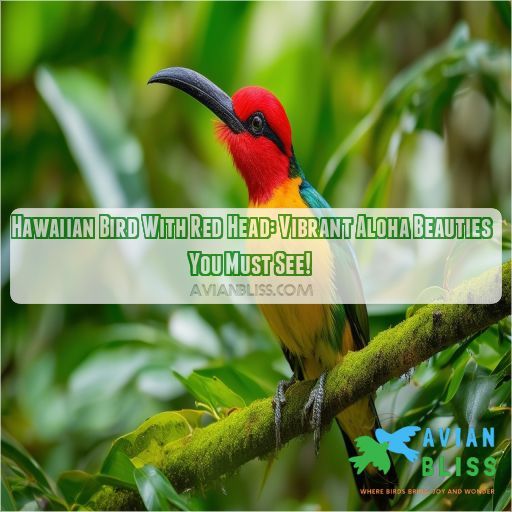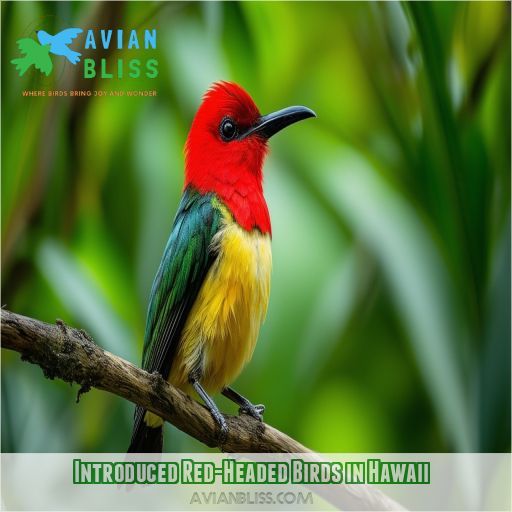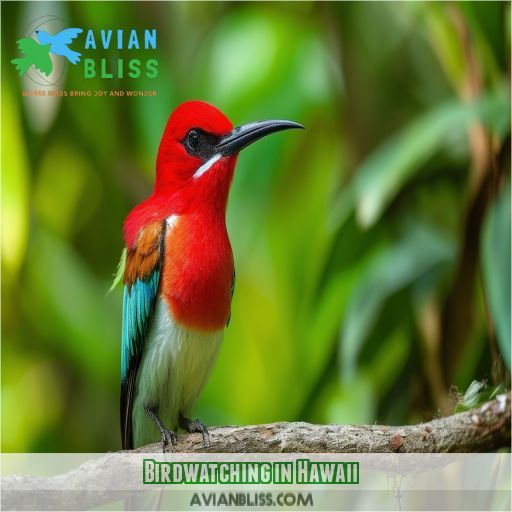This site is supported by our readers. We may earn a commission, at no cost to you, if you purchase through links.

You will come across the Apapane and local ‘I’iwi, while the Red-crested Cardinal is an introduced species. Each type bears amusing features and ecological roles very much on its own.
While wandering through these islands, these red-headed Hawaiian birds have more relevance to visual pleasure than to serve as a window into the complex avian ecosystem of Hawaii.
Learn about understanding and appreciating these lively creatures during your island adventure.
Table Of Contents
- Key Takeaways
- Native Red-Headed Birds in Hawaii
- Introduced Red-Headed Birds in Hawaii
- Ecological Impact and Conservation
- Birdwatching in Hawaii
- Frequently Asked Questions (FAQs)
- What bird in Hawaii has a red head?
- How did the Red-crested Cardinal get to Hawaii?
- What is the rare red bird in Hawaii?
- What is the red native bird in Hawaii?
- Are there red headed birds in Hawaii?
- What is a red crested cardinal in Hawaii?
- What birds live in Hawaii?
- What does a red headed bird look like?
- Are red-headed birds in Hawaii poisonous to touch?
- Can red-headed Hawaiian birds be kept as pets?
- Do red-headed birds in Hawaii migrate seasonally?
- What predators hunt red-headed birds in Hawaii?
- How do red-headed Hawaiian birds communicate with each other?
- Conclusion
Key Takeaways
- Hawaii’s vibrant red-headed birds are like living jewels scattered across a lush green canvas – from the native ‘I’iwi and ‘Apapane to introduced show-stoppers like the Red-crested Cardinal.
- These feathered fashionistas aren’t just pretty faces – native species play crucial roles as pollinators, while introduced birds have stirred up quite the ecological cocktail.
- Birdwatching in Hawaii is a dawn-to-dusk affair – early birds catch the worm (or in this case, the best views), so grab your binoculars and hit those trails!
- Conservation is the name of the game – with over 60% of Hawaii’s native birds singing their swan song, every effort to protect these winged wonders counts.
Native Red-Headed Birds in Hawaii
There, you’ll find three native Hawaiian birds with bright red heads: the Apapane, ‘I’iwi, and the Akohekohe. These endemic species are beautiful, but they also play important roles in the Hawaii ecosystem by serving as pollinators for native plants.
Apapane
You’ll be happy to see the highly colored Apapane, one of Hawaii’s most magnificent native birds: this crimson beauty and utterly Hawaiian jewel is found widely over the islands. Here’s what makes the Apapane a must-see:
-
Beautiful, dark red plumage
● Black wings and tail in striking contrast
• White rump and undertail distinctive
- Prefers high-altitude forest habitats
- Critical to the health of Hawaiian ecosystems
At altitudes above 4,100 feet, venture into forests to see these scarlet wonders in action. All of these make them a fascinating subject of study because of their behavior and habitat preference for birdwatchers and conservationists alike.
‘I’iwi
You’ll also be smitten with another beautiful red-headed bird of Hawai’i: the ‘I’iwi. This brilliant jewel boasts:
- Fiery red plumage that picks out
-
A unique twisted, sickle-shaped beak
• A critical role as a pollinator of native flowers
The ‘I’iwi is the highest nectar consumer, mainly from the blossoms of ‘ōhi’a lehua. Their lifetime and the state of conservation are very closely related to the health situation of the native forests in Hawaii.
Akohekohe
As you explore Hawaii’s red-headed birds, you’ll encounter the impressive Akohekohe. This largest crested honeycreeper stands out with its striking redhead and white-gray plumage. Here’s what makes the Akohekohe unique:
- Distinctive curved beak for pollination
- Adapted to high-altitude habitats
- Critically endangered status
- Evolved from finch ancestors
- Subject of intensive conservation efforts
Don’t miss your chance to spot this rare Hawaiian gem during your birdwatching adventure!
Introduced Red-Headed Birds in Hawaii
You’ll find several introduced red-headed birds in Hawaii that have become part of the islands’ avian landscape. Two notable species are the Red-crested Cardinal, with its striking red head and crest, and the Northern Cardinal, known for its all-red plumage in males, both of which have adapted well to Hawaii’s diverse habitats.
Red-crested Cardinal
You’ll be captivated by the Red-crested Cardinal, an introduced beauty from South America. With its striking red head and crest, this bird adds a splash of color to Hawaii’s landscapes. You’ll find these charismatic creatures in parks, lawns, and tropical shrublands, where they forage for seeds and insects.
Here’s what makes the Red-crested Cardinal a must-see:
- Brilliant red head and crest contrasting with white underparts
- Light grey back that complements its vibrant features
- Adaptable nature, thriving in both urban and rural settings
- Melodious songs that’ll enchant your ears
- Fascinating behavior, often seen in pairs or small groups
Northern Cardinal
You’ll spot the Northern Cardinal, an introduced species in the Hawaiian Islands, with its striking appearance. During mating season, males flaunt brilliant red plumage, while females sport a more subdued brown coloration. These red-headed birds add a splash of color to the islands’ landscapes.
- Easy to identify with their distinctive crest and black face mask
- Often seen in pairs, entertaining birdwatchers with their melodious songs
- Adaptable to various habitats, from urban gardens to forest edges
Other Introduced Species
While the Northern Cardinal is a familiar sight, other introduced red-headed birds also call Hawaii home. You’ll find a diverse array of these vibrant visitors, each adding a unique splash of color to the islands’ landscapes. Keep your eyes peeled for:
- The Red-billed Leiothrix, with its olive-green back and yellow-orange throat
- The Brazilian Cardinal, sporting a striking red head and gray body
- The House Finch, boasting a fuzzy red head and chest
These feathered immigrants have adapted well, mastering their new Hawaiian habitats.
Ecological Impact and Conservation
You’ll find that introduced red-headed birds in Hawaii have had a significant negative impact on native biodiversity, competing with endemic species for resources and potentially spreading diseases. To combat these threats, conservation efforts focus on habitat restoration, predator control, and public education to protect Hawaii’s unique native birds.
Negative Impact on Native Biodiversity
While red-headed birds add vibrant splashes of color to Hawaii’s landscapes, introduced species like the Brazilian cardinal and yellow-billed cardinal pose significant threats to native biodiversity. As you explore the islands with your field guide in hand, consider the hidden impacts these beautiful invaders have:
- Competition for limited resources
- Habitat loss for endemic species
- Disease transmission to vulnerable populations
- Ecosystem imbalance due to invasive species
- Displacement of native birds from their natural habitats
Conservation Efforts
To combat these threats, conservation efforts are in full swing. You’ll find dedicated teams working tirelessly to protect Hawaii’s vibrant avian residents. Here’s what’s being done:
- Habitat restoration to recreate native ecosystems
- Captive breeding programs to boost populations
- Predator control to safeguard vulnerable species
- Public awareness campaigns to educate about invasive species
Birdwatching in Hawaii
To spot Hawaii’s vibrant red-headed birds, you’ll want to visit early in the morning or late afternoon when they’re most active. Bring binoculars and a field guide to enhance your birdwatching experience, and remember to respect wildlife by staying on designated trails and maintaining a safe distance from the birds.
Tips for Birdwatchers
Timing is essential in your red-headed Hawaii birdwatching adventure. Early morning and late afternoons are best when most birds become active. Binoculars and a field guide would help get more from this trip. Always be responsible while viewing the birds; it’s vital in projecting habitat preservation and conservation efforts.
- Respect wildlife by maintaining a safe distance
- Stay on designated trails and roads to reduce impacts to ecosystems
- Understand the impacts of invasive species in order to develop a deeper appreciation for conservation efforts
Frequently Asked Questions (FAQs)
What bird in Hawaii has a red head?
You’ll spot several red-headed birds in Hawaii. The native ‘I’iwi and Apapane are striking endemics, while introduced species like the Northern Cardinal and Red-crested Cardinal add vibrant splashes of color to the islands’ diverse avian landscape.
How did the Red-crested Cardinal get to Hawaii?
You’ll find the Red-crested Cardinal’s journey to Hawaii quite interesting. It wasn’t a natural migration; humans introduced these striking birds from South America in the 1930s. They’ve since thrived, becoming a common sight on several Hawaiian islands.
What is the rare red bird in Hawaii?
Like a scarlet gem in Hawaii’s emerald forests, the ‘I’iwi stands out. You’ll spot this rare beauty with its fiery plumage and curved beak. It’s a native honeycreeper that’s becoming increasingly uncommon due to habitat loss.
What is the red native bird in Hawaii?
You will see two endemic Hawaiian birds showing bright red heads: the ‘I’iwi and the Apapane. These two endemic honeycreepers are the most important pollinators in Hawaii’s forests. You’ll find them at higher elevations, primarily on Kauai and the Big Island.
Are there red headed birds in Hawaii?
Yes, you’ll find several red-headed birds in Hawaii. Native species like the ‘I’iwi and Apapane boast vibrant red plumage, while introduced birds such as the Northern Cardinal and Red-crested Cardinal also sport eye-catching red heads.
What is a red crested cardinal in Hawaii?
You’ll spot red-crested cardinals easily in Hawaii. These introduced birds have striking red heads and crests, with gray bodies. They’re not native but have adapted well, often seen in parks and gardens across the islands.
What birds live in Hawaii?
You’ll find a diverse array of birds in Hawaii. From native species like the ‘I’iwi and Nene goose to introduced birds such as cardinals and mynas, the islands offer a unique mix of avian life to explore and enjoy.
What does a red headed bird look like?
You’ll spot a red-headed bird by its vibrant crimson crown. It’s a striking sight, contrasting with the rest of its body. Look for the bold splash of color atop its head, standing out against its plumage.
Are red-headed birds in Hawaii poisonous to touch?
You don’t need to worry about touching red-headed birds in Hawaii. They’re not poisonous. However, it’s best to admire them from a distance to protect both you and the birds. Enjoy their beauty without disturbing them.
Can red-headed Hawaiian birds be kept as pets?
You can’t legally keep native Hawaiian birds as pets. It’s against federal law to capture or possess them. However, you’re allowed to keep some introduced species, like the red-crested cardinal, with proper permits and care.
Do red-headed birds in Hawaii migrate seasonally?
Like a colorful dance, Hawaii’s red-headed birds don’t migrate seasonally. You’ll find these vibrant residents year-round. They’ve adapted to the islands’ stable climate, staying put in their lush habitats. Enjoy spotting them anytime you visit!
What predators hunt red-headed birds in Hawaii?
You’ll find that introduced predators pose the biggest threat to red-headed birds in Hawaii. Feral cats, rats, and mongooses hunt them relentlessly. Native hawks occasionally prey on them too, but they’re not as significant a threat.
How do red-headed Hawaiian birds communicate with each other?
You’ll hear red-headed Hawaiian birds communicate through various vocalizations. They use songs, calls, and warning cries to attract mates, defend territory, and alert others to danger. Some species also employ visual displays with their vibrant plumage.
Conclusion
Did you know that over 60% of Hawaii’s native bird species are extinct?
As you explore the islands, you’ll encounter various Hawaiian birds with red heads, both native and introduced. While these vibrant beauties add color to the landscape, they also represent a complex ecological story.
By understanding their roles and the conservation efforts in place, you’ll gain a deeper appreciation for Hawaii’s unique avian ecosystem.
Remember to bird responsibly and support local conservation initiatives during your visit.




0 Comments